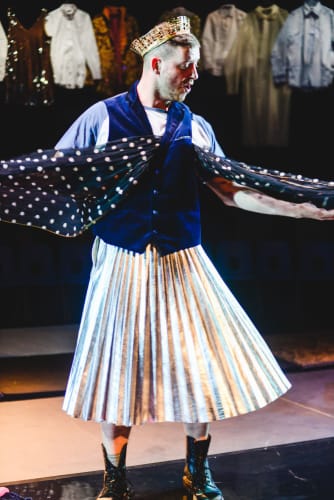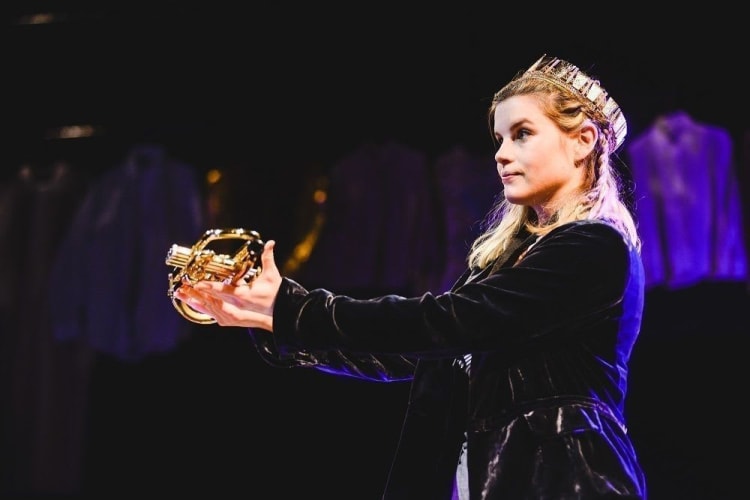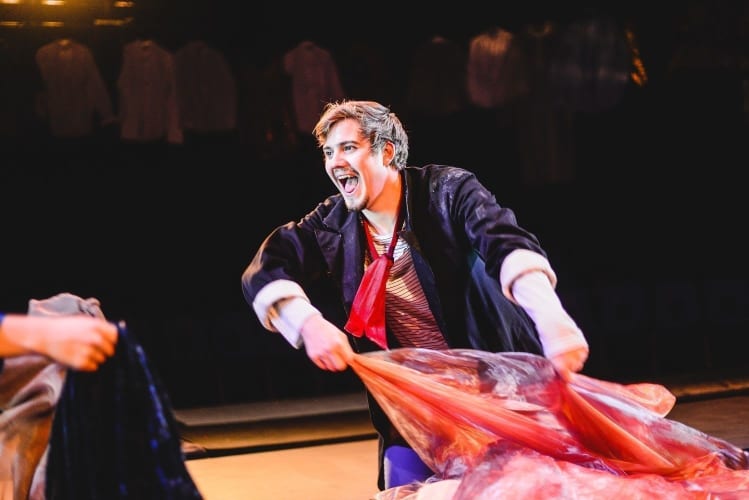The second of the Sherman’s Christmas shows for 2016 (the other being family adventure The Borrowers), The Emperor’s New Clothes (which returns to its host venue after an extensive tour) is aimed at audiences of between 3 and 6 (and performed in both English and Welsh-language versions). It is a minimalistic adaptation of Hans Christian Andersen’s tale of punctured pomposity.
Charlotte Neville’s design transforms the studio theatre into a giant dressing-up box, with clothes draped all around the walls, and the performance area dominated by clothing-racks.
Prior to the performance, the cast informally interact with those audience-members (mostly children), who are seated on the floor, before a fanfare heralds the beginning of Alun Saunders’s inventive take on the story.
We meet the young Kare, played by Geraint Rhys Edwards. He is a playful and wilful child, who is something of a handful. His parents—The Emperor and Empress, played by Tobias Weatherburn and Elin Phillips—inform him that, at some point, he will assume the imperial role.
He accompanies them on a royal parade, which ends in disaster (although this is rendered somewhat vaguely). As a result of this embarrassment, Kare loses his “silly”, and becomes over-serious, his only indulgence being a fondness for “cool” clothes; most notably an ensemble featuring a black jacket overburdened with zips, and a silver skirt.
On becoming the Emperor, Kare puts out the word that he seeks a new set of clothes, with which he can impress the populace on his next parade. The news catches the ear of a couple of chancers—Philips and Weatherburn—who are drawn by the promise of a handsome reward.
The show is directed by Kevin Lewis, who has vast experience of creating work for young audiences; thus the performers are relaxed in respect of the occasional interruption from a spectator, although they stop short of actively interacting with them.
Edwards is believably capricious as the child Emperor who matures into a man whose moodiness stops just short of menacing. He is ripe to be taken advantage of, but relatable enough that one is relieved that the plotline does not call for his complete humiliation.
Weatherburn and Phillips are sympathetic both as the loving parents and the nervously rascally weavers. In addition, they do double duty as musicians (guitar / banjo and saxophone / clarinet respectively), playing Dan Lawrence’s melodic song score; Edwards also contributes suitably regal trumpet.
Much of the story is conveyed via movement; from the Emperor’s exuberant dancing (which went down particularly well) to the weavers’ careful handling of the invisible cloth of which his new outfit is made—the choreographer is Jem Treays.
The original moral of Andersen’s tale (be wary of excessive self-regard, undue deference, etc) is largely abandoned in favour of the message that it is important to be able to laugh at oneself. There is also the suggestion that it is better to confront one’s failings rather than hide behind them.
During the very well-attended press show, the young audience were kept amused and engaged throughout, the inevitable interjections tending to be responses to the narrative. At around fifty minutes, the story-telling is brisk and full of easy charm.
Highly recommended for under-sevens of all ages.


